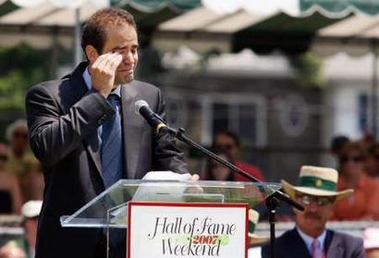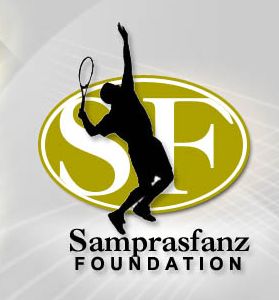Samprasfanz » Archives 2003 to 2011 » Induction for Sampras an honor, and relief
Induction for Sampras an honor, and relief
By Bud Collins, Boston Globe
July 15, 2007

NEWPORT, R.I. — Pete Sampras and Arantxa Sanchez Vicario were in town, gracing the Casino, the elder among the planet’s tennis parlors. No, they weren’t making comebacks. Rather, they were coming into new roles among the game’s immortals, tapped for hard-earned, lofty membership in the International Tennis Hall of Fame, along with Sven Davidson and Russ Adams.
This was the time, every second Saturday of July, when the past upstages the present. Semifinals of the Jimmy Van Alen Cup, the lone grass-court presentation of the ATP Tour in the US, went on as billed. But for a day, a glorious, sunny, and seabreezy afternoon, the tournament was overshadowed by the Fame Class of ’07, appearing to collect their reward for bygone greatness. (Other than Adams, a 77-year-old Reading, Mass., resident continuing his photographic artistry, they are out of the tennis business.)
They’ll be playing Gaul ball for the championship today, an unprecedented all-French final that pits serve-and-volleying No. 83 Nicolas Mahut against No. 68 Fabrice Santoro. A strong finish gave Mahut a 6-4, 6-7 (2-7), 6-2 decision over 36-year-old Belgian lefty Dick Norman.
A clever trickster, double-handed both ways, Santoro used his wiles — spins and angles — to subdue South African Wesley Moodie, 7-6 (7-2), 6-3, to attain his first final since winning Dubai five years ago.
As the coolest cat ever to prowl Centre Court, seizing a record seven Wimbledon titles, humble Pete choked on the Casino lawn, overcome by the occasion. His acceptance speech, written for a five-minute distance, seemed more like five sets — “six sets,” laughed his father, Sam Sampras. Punctuated by sobs, blank intervals, gulps, and disjointed sentences, it ran 25 nervous minutes.
“By far the hardest time I’ve had on a tennis court,” Pete was finally able to smile. Here was Pete Sampras, he of the mesmerizing running forehand, explosive serve-and-volley, and 64 singles titles, stumbling on the doorstep to Fame. “It was tough without a racket.”
“You got all day, baby!” came one sympathetic voice from the full-house congregation of 3,781. Numerous calls of “We love you, Pete!” tried to help him in the emotional meltdown.
Besides his Wimbledons, Sampras has five US and two Australian titles for a record total of 14 majors. He has “no idea how or why” he got into tennis. “I was 7, and picked up an old racket that was in the house, and started to hit a ball against a wall. I had hand-eye coordination and liked it. My dad said I could have some lessons.”
That was 1978. Twelve years later he was the youngest US champion, but not settled in. Losing his crown in the quarters a year later, he expressed “relief” from the pressure at the defeat by Jim Courier, and was mercilessly knocked by Jimmy Connors. “At first I resented it,” Pete says, “but then I thought it was true — I wasn’t tough enough and had to work harder. Losing the 1992 US final to Stefan Edberg was a wake-up call. I gave up in the fourth set. It hurt. That loss changed my life. I went to work, determined to be No. 1.”
Which he was for the following six years, also a record. “It was lonely at the top. Week in and week out I was everybody’s target. Not much offseason. It was stressful, but worth it. I had a lot of great moments, but my last year [2002] had maybe the high and low.”
Sanchez Vicario, the vivacious “Barcelona Bumblebee,” was proud to be the first Spanish woman in the Hall, and the second Spaniard, following Manolo Santana [Class of ’84]. And, she said, one of the few Famers able to make such a statement, “I won a championship on this court.” In 1990, as an 18-year-old, she beat Jo Durie to win the Casino’s female tourney.
Arantxa, winner of the French in 1989, 1994, and 1998, and the US in 1994, plus 11 doubles majors, was justifiably pleased by her completeness: 29 singles, 67 doubles prizes. “I’m glad that my year, this year, is the first year for equal prize money at the four majors.”
Lesser known, Davidson, who turned 79 Friday, was the first Swede to win a major, the French of 1957. A longtime winner of European titles, he bore up graciously though seriously ill. Dignified in acknowledging his selection, Sven introduced a poignant note, saying, “I have been diagnosed with Alzheimer’s.”
This was all new to Adams, the small-town guy out of Spencer, Mass., who trotted the world to make memorable tennis pictures. Having photographed innumerable players since 1955, and all the Hall of Famers, he was now on the other side, the subject of a platoon of lensfolk.
He said, “I was ignorant of the game at first, didn’t know how to keep score. Somebody wanted me to take a picture of a player volleying, and I said, ‘What’s a volley?’ But I had to learn. I think the New England Juniors at Longwood was my first tournament. Mrs. Wightman [the grand dame of tennis then, Hazel Wightman] took me under her wing. She stood beside me beside the court, and jabbed me with an elbow when she thought I should shoot.”
Nobody has to jab anymore. He’s fond of a shot at the US Open of 1968: “Arthur Ashe and his father, hugging and crying after Arthur unexpectedly won his initial major.”
Source: Boston Globe
Filed under: Archives 2003 to 2011










